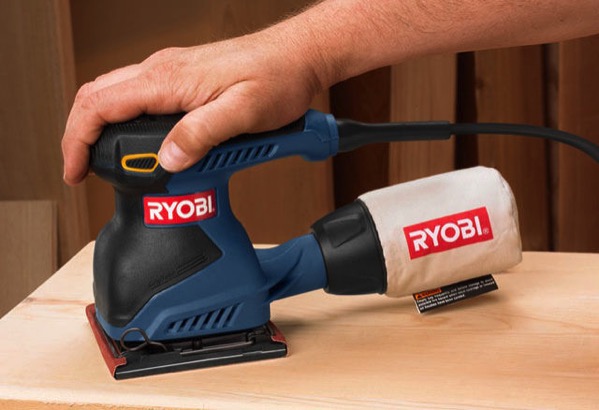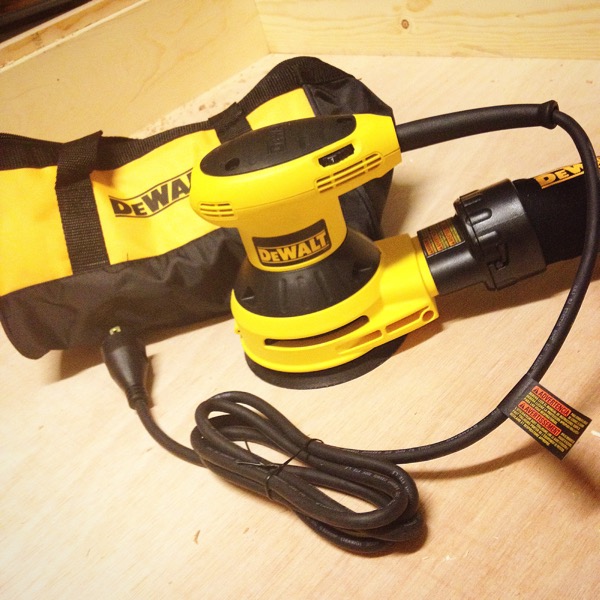And since there may be a little confusion about which tool is the ‘right’ one for the job, I thought I’d spend a little time today going over the differences in both tools and the pros and cons of each one. I’m not including Belt Sanders on this list for the same reasons I’m not including floor sanders: (1) I don’t have one and (2) it is a heavy duty tool for a very specific niche: Heavily sanding down large flat surfaces. I’m only going to talk about light-duty/multi-purpose sanders that most DIY’rs could use on a regular basis.
The Finishing Sander
Also known as: Palm Sander, Orbital Finishing Sander, Orbital Sander, Quarter Sheet Sander
Pros:
Inexpensive
Lightweight
Uses 1/4 of standard sand paper sheets. (Less expensive to operate)
Easy to control
Works best with ultra-smooth surfaces and extremely high grit sandpaper
Difficult to ‘oversand’ and take off too much material unintentionally
Great for in-between paint coats
Can sand up into corners
Works well for rounding down sharp edges
Not extremely loud
Cons:
High vibration (my arm always feels like it is numb after using an orbital sander)
Cannot remove lots of material
Can result in ’swirly’ sanding patterns because of the receptive rotating action.
Doesn’t work well on really rough surfaces
Dust collection is not as efficient since sandpaper is not pre-punched
Using standard sandpaper means it is more likely to tear and replacement can be time consuming
Inexpensive
Lightweight
Uses 1/4 of standard sand paper sheets. (Less expensive to operate)
Easy to control
Works best with ultra-smooth surfaces and extremely high grit sandpaper
Difficult to ‘oversand’ and take off too much material unintentionally
Great for in-between paint coats
Can sand up into corners
Works well for rounding down sharp edges
Not extremely loud
Cons:
High vibration (my arm always feels like it is numb after using an orbital sander)
Cannot remove lots of material
Can result in ’swirly’ sanding patterns because of the receptive rotating action.
Doesn’t work well on really rough surfaces
Dust collection is not as efficient since sandpaper is not pre-punched
Using standard sandpaper means it is more likely to tear and replacement can be time consuming
This orbital type of sander uses spring loaded clamps to hold squares of sandpaper on a cushioned pad and rotates it in tiny circles at super high speeds. It has a palm grip on top and depending on model has either a single speed or adjustable speed for different projects. It is easy to control, light weight and not extremely loud. Because it is designed for fine finishing work, it is a great tool for beginners since you are very unlikely to damage a surface by over-sanding it, however you can get circular (swirl) marks if you leave the sander in one place for too long.
I personally own this Ryobi model (mine is older so it is blue), which has lasted for a long time. In fact, I sanded 100% of my kitchen cabinets with it before painting. It is workhorse. My model has a jig which punches holes in the sandpaper and allows for it to be sucked into a collection bag (to keep dust down) but because they are not pre-punched holes, it can still be a dusty process.
Palm sanders are so easy to control, that I have actually let my 4 year old use one:

And for under $30 I would say it is a tool that is worth having in your arsenal. If you are willing to spend a little more money, you can move up from the 2.0 Amp version I posted above, to a heavier duty palm sander, like this 3.0 Amp version from Milwaukee ($60). It will give you a little more power, but you still wouldn’t want to use it sand down extremely rough timber. That is just not what a finishing sander is for.
The Random Orbit Sander
Also known as: Orbit Sander, Disc Sander
Pros:
Powerful
Less vibration and easier to hold onto for long periods of time.
Works well on really rough surfaces and can remove a lot of material quickly, especially with low grit sandpaper.
Also works well for fine polishing and high grit finishing sanding
More versatile than a finishing sander
Doesn’t leave swirly marks on surfaces
Good dust collection
Sanding discs are heavy duty and rarely tear
Cons:
More expensive to buy
More expensive to use: Uses pre-cut sanding circles (with either adhesive or velcro)
Slightly harder to control
More difficult to get into corners
Since it is more powerful it is easier to ‘overland’ and damage surface
Works well for rounding down sharp edges
Slightly louder
Powerful
Less vibration and easier to hold onto for long periods of time.
Works well on really rough surfaces and can remove a lot of material quickly, especially with low grit sandpaper.
Also works well for fine polishing and high grit finishing sanding
More versatile than a finishing sander
Doesn’t leave swirly marks on surfaces
Good dust collection
Sanding discs are heavy duty and rarely tear
Cons:
More expensive to buy
More expensive to use: Uses pre-cut sanding circles (with either adhesive or velcro)
Slightly harder to control
More difficult to get into corners
Since it is more powerful it is easier to ‘overland’ and damage surface
Works well for rounding down sharp edges
Slightly louder
Random orbit sanders not only rotate quickly in little circles, they also spin the entire sandpaper disk around in 360 degrees while doing so. That is why the sanding pad on a random orbit sander is circular. That is also why you cannot use standard sand paper on them, you need to buy pre-punched sanding discs which are designed to fit whichever model you own. Depending on model random orbit sanders can either be single or variable speed, and they can come with either a single palm grip, or with an addiontal handle and barrel grip (like this super heavy duty model):
Most random orbit sanders have a 5 inch sanding surface, but some are larger (6 inches). Unlike the finishing sander, which uses clips to hold the sandpaper, the circular pads on these sanders hold via adhesive or hook and loop (Velcro) attachments.

This mid range Dewalt is the Random Orbit Sander ($80) I recently purchased myself. I wanted to make sure whatever I chose came with variable speeds and this fit the bill. If you want to save some money, you can get a single speed version for only $60 or there is this slightly less powerful Ryobi option for about $40.

The ‘random’ part of the random orbit sander is what results in the fine finish without any swirl marks. However, it is possible to sand away too much of the surface without meaning to if you aren’t careful. Because these sanders are so much more powerful they do take off material more aggressively and are more difficult to control.
So which one is right for me?
If you are only going to buy ONE sander, I would say the random orbital is your best option since it goes from course to fine sanding easily. If you are doing a lot of fine finishing work and want to save some money (and not have to lift such a heavy sander) then a finishing sander is worth the small investment. And really, if you have both of them, you are pretty much 100% covered!




